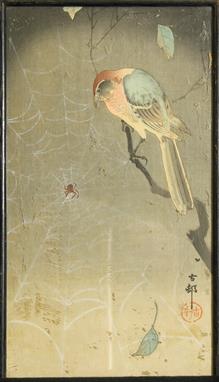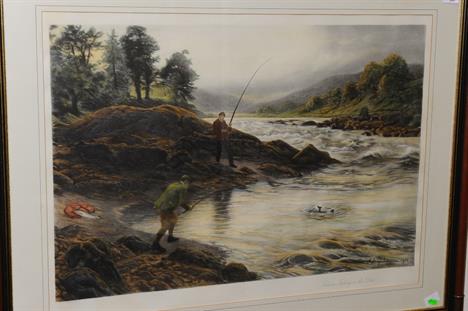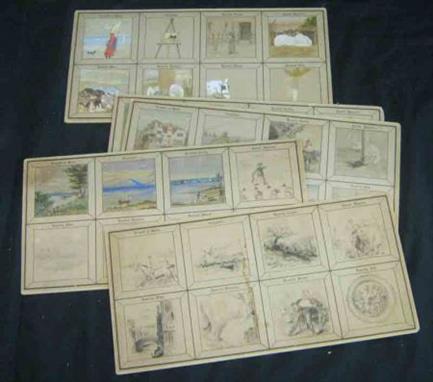315264 Preisdatenbank Los(e) gefunden, die Ihrer Suche entsprechen
315264 Lose gefunden, die zu Ihrer Suche passen. Abonnieren Sie die Preisdatenbank, um sofortigen Zugriff auf alle Dienstleistungen der Preisdatenbank zu haben.
Preisdatenbank abonnieren- Liste
- Galerie
-
315264 Los(e)/Seite
Moffat (Robert) MISSIONARY LABOURS AND SCENES IN SOUTHERN AFRICA 8vo (230 x 15 mm) Second thousand: 624 pages (8 pages of publisher’s catalogue bound in before the frontispiece), colour frontispiece "The Mission Premises at the Kuruman Station" is printed by the Baxter process, folding map, 8 engraved plates, 8 engraved illustrations in the text, original blind stamped cloth with gilt titling on the spine, edges uncut, bookplate on the front paste-down endpaper. The cloth is dull and rubbed and is worn at the corners and along the edges and is chipped at the top and bottom of the spine, signature of a previous owner at the top of the title page, small stains on the title page which correspond on the frontispiece opposite, generally the contents are crisp and free of foxing. Mendelssohn (Sydney) South African Bibliography, volume 2, page 29. `The preliminary chapters deal with opinions of the author on the origin of the Hottentots, and gives a synopsis of the early work of the London Missionary Society in South Africa, reference being made to the labours of Drs. Vanderkemp and Philip, and other pioneer missionaries who predated Mr. Moffat. The volume gives a valuable account of mission work among the Bechuanas, with notes on the customs of the natives, and a description of the earlier travels of the author. There are some particulars concerning Dr Andrew Smith`s expedition into the interior in 1835, and there is an ample account of the labours of the various missionary societies engaged amongst the Bechuanas, Matabeles, Basutos and other races at this period`. The coloured frontispiece of the Kuruman Station is one of very few illustrations printed by the Baxter process in books of African interest. This plate was also sold separately as a print to raise funds for the work of the mission. Fair London John Snow 1842 Reserve: $100 Click here to view further details and to bid
Goldblatt (P.) & Manning (J.) GLADIOLUS IN SOUTHERN AFRICA 4to (310 x 235 mm) Watercolours by Fay Anderson & Auriol Batten, Line drawings by John Manning. Collectors’ Edition: 320 pages, tipped in colour frontispiece and 144 colour plates, many line drawings and distribution maps, bound by Peter Carstens in half green morocco and grey cloth sides, contained in a grey cloth slip case with leather lips and an illustration mounted on the upper panel, a very good copy. Collectors’ Edition. A Special edition limited to 100 copies. This is number 75, signed by the authors and containing an additional tipped-in print, numbered 75/100 and signed by the Fay Anderson. ‘One of the most important botanical studies published in recent times, this monograph of the genus Gladiolus in southern Africa combines the artistry of two of the world`s foremost botanical illustrators with the meticulous work of two highly respected biologists. The exquisitely delicate watercolour paintings by Fay Anderson and Auriol Batten capture faithfully the fragile elegance of almost all the Gladiolus species of the region.’ Editor`s note. Cape Town Fernwood Press 1998 Reserve: $100 Click here to view further details and to bid
John Fairbairn Autograph letters signed, 8 items. various letter formats Autograph letters in his own hand and signed, to Benjamin Moodie in Swellendam. John Fairbairn emigrated to South Africa, following his friend Thomas Pringle to the Cape, in 1823. He is remembered today as the father of press freedom in South Africa as well as an educationalist and the founder and first Chairman of the Old Mutual (certain of their premium investments carry his name under the Fairbairn Trust). This collection of letters from his early years at the Cape to his friend Benjamin Moodie then living in Swellendam reflect early concerns with a free press, slavery, the strife with the autocratic Sir Charles Somerset, then governor of the Cape, and the problems of the Settlers. The letters are the originals as written in his own hand and were folded, sealed, and posted. The results of this are clearly visible. A few of the letters are extant as typed copies, probably copied from his own fair copy or letterbook. Some may be the only copies. These items are unique in the true sense of the word. 1. Letter postmarked June 10 1825. 3 sides of writing. Personal health & finance issues, a memorial concerning slavery at the Cape, fixing the rate of the Rixdollar & a petition in the Burgher Senate re same, handling of complaints from the Colony, financial issues & proposed new bank, state of alarm as 50,000 threaten the Frontier, request for articles, comments on various administrative figures, etc. Condition: complete with no major loss. several small holes at folds passing through front to back. Does not impair legibility. 2. Letter postmarked August 26 1825. 3 sides of writing. Problems arising with Greigs type which had been sold to Bridekirk rendering him unable to print and publish, further issues with the legality of printing the paper under the partisan handling of the issue by Lord Charles Somerset`s administration, plans to bring the arbitrary local government to the attention of Parliament in London, to have Lord Charles Somerset impeached or recalled, etc. Condition: bottom edges frittered but not seriously affecting legibility. side 3 has some loss. a 100mm x 30mm loss to text written on outer edge, a hole (the size of a South African R2.00 coin, or a nickel) in the middle of the text, and a comparable area at the bottom edge. 3. Letter postmarked September 9 1825. 2 sides of writing. A list of 27 suggested articles, comments upon the Commissioners, Lord Charles Somerset, Greig`s types. Condition: minor loss to side 3 not affecting any text. 4. Letter dated March 9 1826 (postmark not visible). 3 sides of writing. `Open war` on Greig, Atherstone on confidential footing (with Lord C?), Richard Bourke advises Greig to abide by his prospectus and eschew further open hostility to Somerset, no one will sign address to Lord Charles Somerset who leaves the colony - leaving his children behind to the disgust of the ladies. Condition: 4 areas of small loss to edges and one small hole. the letter fold is torn to about 1/3 of the height from the top. some text is missing but the letter loses little legibility. 5. Letter dated 24 March 1826. (postmark not visible) 3 sides of writing. Issues concerning local banking, comments on Lord Charles Somerset, Pringle to leave in the Lucia, new family [Bourke?] religious and ban Sunday music & dancing, Fairbairn in low spirits, restrictions on internal trade. Condition: Two areas of loss to side 3, a 30mm hole in the middle and a similar area at the edge. the former gives text loss, but the latter does not. 6.Letter dated October 5 1826. (postmark not visible). 3 sides of writing. Stamp to be levied on all newspapers, Stellenbosch recusants threatened with transportation, events onboard the Atlas between Brink & Shaw reported in the British press, letter from depressed Pringle in UK, complaints on the low literary level of current British writings, general dismay at state of world affairs. Condition: minor tear on edge of side 1 not affecting legibility, small loss (the size of a South African R2.00 coin, or a nickel) to the edge of side 3 not seriously affecting legibility. 7. Letter dated September 30 1828. 1 written side of 3. Complaint that the Commissioners failed to institute an enquiry into the conduct of Lord Charles Somerset, ideas of literary property, proposed new periodical. Condition: one small hole in front not affecting legibility. major loss to side 3 but there is no text to be affected there. 8. Letter dated Saturday morning, Grahamstown. 4 sides, incomplete. Not addressed to any one, nor signed, but likely his friend Moodie as usual. This does seem to be in the style of Fairbairn. Probably written at some date before the departure of Lord Charles Somerset, so maybe 1826. At the time of writing he was in the Eastern Cape. Condition: excellent, no loss or damage. As noted, the condition of these items varies. Some of them have pieces missing either from handling over the years or from opening them as were sealed for postage. A full set of scans are available on request for you to evaluate the overall condition of each item. We have transcribed the letters to the best of the ability and scholarship within the time constraints. These are available as pdf files on request. Following a successful bid by a recognised institution such as a university library, we can provide an invoice for payment on provision of an official order for this item. Please make a formal request to us in advance if you wish to do this. An export permit may be required for this item and it is the responsibility of the purchaser to obtain this. Variable. scans available Reserve: $5000 Click here to view further details and to bid
Van der Linden, Johannes Regtsgeleerd, Practicaal en Koopmans Handboek ([1806]) 210 x 140 Although we have not traced any other copies of this now rare early 19th century Roman-Dutch law treatise, `print on demand` copies of a similar title, by `Joannes` van der Linden and Johannes Allart, are listed on the AbeBooks website. From the signature on the half-title page and the initials on the top page edge, this copy is likely to have been in the ownership of the J E R de Villiers who was a former judge-president of the Orange Free State and an Acting Appeal Court judge, and who referred to it in some of his judgments. The title-page has been lost and, with it, the name of the publisher, but this copy seems to have been published in Amsterdam in 1806. Johannes van der Linden’s “Regtsgeleerd, Practicaal en Koopmans Handboek” is referred to in R W Lee’s “Introduction to Roman-Dutch Law” (Oxford, 1931) as both one of the last authorities on “the old [Roman-Dutch] law” and the earliest on “the new law”. When this copy was found, in an auction job-lot, the covers were badly damaged, but the contents were sufficiently valuable to justify rebinding. This has been done in brown goatskin with an abbreviation of the title gilt lettered on a spine panel, new red-and-green head and tail bands, new endpapers and a new marker ribbon. The contents of lxxiv + 588 pp include an introduction, text divided into four books, and an index. The introduction includes a 30 pp annotated bibliography of Roman and Roman-Dutch law, including three of Van der Linden’s other titles, published in Leiden between 1794 and 1803. In addition to the missing title-page, part of the half-title and half of the last leaf of the index have been lost and a small section of pp 101/102 has been cut out. There are a few brief marginal notes in ink, probably by the same previous owner. There are brown stains not affecting the text on some twenty early leaves, but the pages are not foxed and the text is otherwise bright and undiscoloured. Already intrinsically rare, this book is unique in its present form. Good [Amsterdam] Unknown [1806] Reserve: $150 Click here to view further details and to bid
John Guille Millais GAME BIRDS AND SHOOTING SKETCHES: ILLUSTRATING THE HABITS, MODES OF CAPTURE, STAGES OF PLUMAGE AND THE HYBRIDS AND VARIETIES WHICH OCCUR AMONST THEM. 17.5 x 23.5 cm 2nd Edition 1894 (1892), Henry Sotheran & Co., London. Octavo, xiii, 185 pp + 16 pp advertisements. Original light brown pictorial boards with black titles to front and facsimile of Millais’ signature. Uncut edges. Frontispiece of Thomas Bewick by Sir John Everett Millais. Illustrated with 18 full page plates, and 38 in text by the author (listed). John Guille `Johnny` Millais (24 March 1865 – 24 March 1931), was the fourth son and seventh child of Sir John Everett Millais, the Pre-Raphaelite painter. He was a British artist, naturalist, gardener and travel writer who specialised in wildlife and flower portraiture. He travelled extensively around the world in the late Victorian period detailing wildlife often for the first time. He is noted for illustrations that are of a particularly exact nature. In 1903 Millais co-founded the Society for the Preservation of the Wild Fauna of the Empire (SPWFE). Clearly a clubbable and convivial man, in 1909 Millais was a founder member of the Shikar Club, a sportsclub where like-minded associates could dine and discuss their passion for hunting especially big game hunting. Millais was passionate about hunting and fellow members included the famous hunters Frederick Selous (the brother of ornithologist Edmund Selous), African game hunter Arthur Henry Neumann, and explorer and hunter Frank Wallace. The club still survives and includes the Duke of Edinburgh amongst its members. Millais is one of the most respected of British ornithologists and bird artists, producing between 1890 and 1914 a series of books on birds and other natural history subjects. In the study of ornithology he was renowned for his portraiture of wildfowl and game birds. Condition: Lacks spine (clean edges with no fraying). Boards gently faded and or darkened. Text block firm, print bright, plates unaged. Age toning to endpapers. Previous owner`s name to fep. Book protected by cellophane wrap. Very Good London Henry Sotheran & Co. 1894 Reserve: $40 Click here to view further details and to bid
TERENCE BRIND: Limited edition col’d Aviation Print “Dawn Handover”, signed by Artist, Johnnie Johnson and one other, Ltd Edn of 750, approx. 16 ¾” x 24”, f/g + DEREK STOCK: Limited edition Print “Dawn of the Spitfire”, signed by “Laddie” Lucas, Johnnie Johnson, Neville Duke and 9 others, Ltd Edn of 250, approx. 12” x 17 ½”, f/g, (2)
A small unmarked German bisque headed doll, with blue sleeping eyes, closed mouth with slight gap between, blonde mohair wig, straight legged composition with moulded and painted black ribbed socks, brown and tan heeled shoes with gold laces, floral print frock and under clothes, possibly Kestner - 7¾in (19.5cm) high
Commonwealth Postal History A fine grouping of postal history items, 3 x pre stamp Cape of Good Hope envelopes, Great Britain QV 1/- to Natal from SG 117, 1908 King Edward VII ½d with Exhibition postmark, a King George V unused registered envelope with Albino print of King’s head, no colour, Transvaal postcard with rare cancel on front and back and Orange Free State to England with 2 pairs one penny purple, also 1970 Lesotho 35s on 75s Postcard. Rare and attractive grouping. 1842/1987
Union Postal History ‘Air’ Postal Stationery: 1942 Airgraph (message photo-print + cover); then Air Letters - 1945 Middle East Forces Xmas (x2 – unused or used (faults)); 1961 2½c Groot Constantia with tape ‘patch’ and 5c Baobab x2 with doctor blade flaws (one prominent); and 1969 5c Aircraft missing red and a second example with ‘red only.’ This last in fair to average condition only but rare. (Quick ref nos. A15A; A78 var; A86 var; A102a var). 1942/1961
John Ogilby - `The Roads from London to Bath and Wells`, hand coloured print, 14" x 18", framed; together with After John Ogilby - `The Roads from London to Bath and Wells`, colour print, 9" x 12" and `The Roads from Carmarthen to Cardigan`, `Cardigan to Llaneeder` and `Llandeder to Aberystwyth`, Mawson, Swan & Morgan label verso, hand coloured print, 13" x 17.5", framed (3)
Jasper plaque of John Wesley, set within gilt frame, together with a 1829 Baxter print of Wesley after Grimaldi set within rosewood frame, also a G. Elliot black basalt plaque of Hugh Bourne framed, (3) the largest frame measures 20cm high Condition report: The jasper plaque is sealed within the frame and therefore cannot be guaranteed. There is a mark to the top of the painted glass mount. The basalt plaque is free from damages. The Baxter print is in good condition with only minor scratches to the frame and wear to the slip mount. `Condition report: see terms and conditions.`
Two John Wesley commemorative pieces circa 1839 to include a loving cup and a mug printed with a portrait of the Reverend together with a print of the Centenary Hall and Mission House London, (2) the loving cup measures 14cm high Condition report Loving cup: large filled section of the foot. Mug: two hairlines and rim chips. `Condition report: see terms and conditions.`
-
315264 Los(e)/Seite






![Van der Linden, Johannes Regtsgeleerd, Practicaal en Koopmans Handboek ([1806]) 210 x 140 Although we have not traced any oth](http://lot-images.atgmedia.com/SR/36503/2893108/44-201311818251_468x382.jpg)




















































